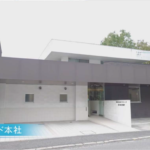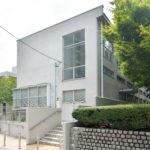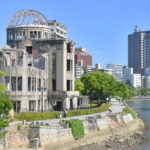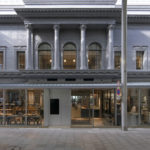IV Building Houses in Hiroshima
On July 17, 1949, a passenger ship, the General Gordon, on which the four members of the project had boarded, departed from the port of San Francisco. Their travel to Japan and project in Hiroshima was summarized in Japan Journey by Schmoe, and Andrews’s dairy in detail. On the way to Japan, the ship stopped by Honolulu, Hawaii and arrived at Yokohama Port on July 31. It was a two-week journey. After disembarking, guided by Tomi Takara, then-member of the House of Councilors and also formerly deputy mayor of Kure, the group headed to Tokyo, where they joined the Japanese volunteers. Six young Japanese volunteers around 20 years old took part. When Schmoe visited Japan in 1948, he called for participation in the project by Japanese young people35.
Learning of Schmoe’s project, Japanese students decided to take part out of feelings such as “wanting to help the people of Hiroshima36.” “Thinking that houses are necessary for a-bomb survivors in Hiroshima, I was deeply moved by Schmoe’s project37.” Along with the Americans, Japanese people also participated in the housing project. Here was another important meaning behind building the houses.
Schmoe believed that by constructing houses through cooperation beyond nationalities and countries, they could understand each other and nurture thoughtfulness. During the war, countries had inflamed hatred and unleashed appalling destruction, including the atomic bombings. Schmoe questioned how to build up a new world to avoid violence.
Then, he considered enhancing thoughtfulness by understanding others who also lost something in the war38.
In addition, Tibbs, a black woman, was among the members coming from the U.S. Though it still persists, at that time, racial discrimination was a major issue in American society. Schmoe wrote in a Christmas card to Tibbs, “To show that there are Americans who feel sorry for atomic bombings and who are against wars and believe in peace, please take part in the housing project in Hiroshima in a group beyond race and religious belief39.” Since Japanese Buddhists participated, there were also differences in religion.
This housing project eloquently communicated to the world the way to build a peaceful planet through cooperation by people of different nationalities, race and religious beliefs.
Having taken on the Japanese volunteers, the group left Tokyo Station for Hiroshima on the morning of August 3. The train was packed and stuffy. On the way, they stayed in Kobe for a night and changed trains, finally arriving in Hiroshima in the afternoon of August 440. Because they had negotiated with Hiroshima Prefecture and City, they attracted much fanfare.
At the station, the governor of Hiroshima Prefecture and the mayor of Hiroshima City welcomed them, and media reporters asked them various questions. A newspaper article reported that Schmoe said, “Peace movements are conducted through actions, not by talk” 41.
After that, the group headed to Hiroshima Nagarekawa Church. Kiyoshi Tanimoto, one of the a-bomb survivors whose life was portrayed in Hersey’s book Hiroshima, served as minister.
Tanimoto had gone on speaking tours in the United States since 1948 to stress the importance of peace and convey his experiences. Schmoe first met Tanimoto in July 1946 during his speaking tour and asked for advice on the Houses for Hiroshima project. A document in which Schmoe called for donations related a conversation in which Tanimoto said he would make every effort to support the Houses for Hiroshima project. Tanimoto laid out a plan to establish research institutes for world peace in Hiroshima, realized as the Hiroshima Peace Center. He played an important role in relief activities in Hiroshima through cooperation with people in Japan and abroad. Hiroshima Nagarekawa Church became accommodation for the group.
Before starting the project, they had time to negotiate with Hiroshima City. As mentioned earlier, Hiroshima City and Prefecture wanted them to build a children’s library. Before Schmoe arrived, a newspaper had reported about library construction42. However, as books to be stored in the library were planned to be offered by the US military and written in English that children could not read43, the plan fizzled out. This library project that Hiroshima City gave up was realized three years later, in 1952, by support from Japanese immigrants abroad. A Hiroshima group residing in Los Angeles, California, donated 4 million yen towards a children’s library, which the city accordingly built44.
The focus of the project again reverted to housing construction. They decided to build and donate two Japanese-style single-story wooden houses partitioned into two units in a Minami-machi area where municipal dwelling houses were under construction at a cost of 180,000 yen (500 dollars)45.
Because it required time to obtain the final approval from city authorities, Schmoe and other members volunteered at Hiroshima Memorial Hospital. From seven in the morning46, they worked at the hospital to support food preparation, bathing, cleaning and laundry.
Because of a lack of disinfectant and medicine47, they provided powdered milk, vitamin supplements, and Streptomycin, which is antibiotics for tuberculosis48.
For patients, interacting with the volunteers was encouraging. They talked and patients sometimes sang hymns. Schmoe and other members showed slides. Even after their volunteer work finished, Schmoe and the other members wrote to patients asking after their conditions, and presented Christmas gifts such as towels and candies49. The housing project started on August 15. Hiroshima residents also took part, making for a total of 40 people, including elementary school teachers and university students50. Although Schmoe experienced a house building project during World War I and was used to carpentry work, he hired carpenters in Hiroshima as he was inexperienced in building Japanese-style houses. Every day, from the Hiroshima Nagarekawa Church where he stayed, he walked to the construction site and worked six days a week during the hot summer (with half a day off on Saturdays). Sometimes, he was wiped roofs in the rain and faced material shortages51. Not everyone was familiar with carpentry work. They learned the basics, such as how to use saws and planes, from carpenters, and all supported each other52. Specifically, Japanese-style houses require mortise holes to connect pieces of wood for framing. Therefore, the volunteers chiseled hundreds of pieces of wood. Regarding the work, Tibbs wrote, “Because of the destruction of the atomic bomb, there were few tools or equipment. We had to start from making bricks for housing. We had to go back and forth from Hiroshima Nagarekawa Church where we stayed to the construction site every day. It was exhausting work and I was worn out by the time we came back to the attic53.” Also, Kouya Azumi, who joined as a student volunteer, recalled, “The hardest work was carrying timber. I purchased quite a large amount of timber at a shop every morning and carried it in a bicycle trailer in the broiling sun54.
Because they needed to cook for themselves, besides carpentry work, they had to do housekeeping as well. They rotated duties such as cooking, washing, shopping, etc.55 Schmoe praised the Japanese women volunteers who dealt with carpentry work and housekeeping in a letter to his friend. He also wrote that Tibbs, who kept a housekeeping book, making a menu and shopping list, was well-suited for this communal living56.
At night, they had meetings where students asked Schmoe the significance of volunteer work and discussed the importance of it57.
However, they were not just working. On Saturday afternoon and Sundays when they did not have work, they watched movies and went to the sea and river for camping58.
They also got to know local people. As radio and newspaper reported on the Houses for Hiroshima project, people visited the construction site and letters were delivered every day. A printing company in Hiroshima featured the project for a children’s magazine and 8th grade students observed the construction site. Students asked about the houses under construction and America. After that, some students started to help with the housing efforts. These elementary school students helped with carrying timber with a cart59 and carrying soil for the garden.
Schmoe and other members were invited to dinner by their acquaintances, had sukiyaki together with nursery school teachers, and observed the printing company which featured the project. Andrews taught at Sunday school at the Hiroshima Nagarekawa Church instead of the teacher who was on summer vacation60.
They also witnessed the reality of the city. On August 6, two days after Schmoe’s arrival, he and other members took part in a peace festival. Hearing speeches by the guests and the ringing of the peace bell, Schmoe was strengthened in his conviction that the foundation of peace was people from different countries working together and promising thoughtfulness and mutual understanding61. They also visited the vicinity of the hypocenter. Andrews was shocked by the destruction and devastation that had occurred in a moment, and ashamed of what the United States did. On a different day, they visited the Hiroshima Red Cross Hospital and met with patients suffering from keloids62.
They also met Norman Cousins, who played an important role in relief activities in Hiroshima. Cousins, who was the chief editor of the Saturday Review of Literature, was also visiting Hiroshima to cover the preparation process of the Hiroshima Peace Center at the same time that Schmoe was staying in the city. Norman visited hospitals and childcare facilities in Hiroshima and reported on the situation in the Saturday Review of Literature. He also introduced the idea of moral adoption, which he had discussed with his friends. Moral adoption was a campaign in which ordinary people overseas served as parents and contributed to the wellbeing of A-bomb orphans. This idea received lots of attention from readers, raising 2,000 dollars (720,000 yen at the time), which was sent to the mayor of Hiroshima City and distributed to orphans. Later on, donation was also distributed to children taken by other facilities and who did not belong to these facilities. It is said that nearly 500 children were supported by this campaign63. This moral adoption campaign was introduced in the 1951 city guide as international support, together with the Houses for Hiroshima project. Hence, 1949 was the year when two unique international support projects launched in Hiroshima64. Schmoe and other members attended a luncheon to welcome Cousins conducted by the Hiroshima City Office and also took part in the ground-breaking ceremony for the Hiroshima Peace Center. This ceremony was broadcast via NBC Radio in the U.S. at the end of August.
In September, there was concern whether they would be able to build two buildings because of a lack of time and funds, but the construction was completed as scheduled. By the time of completion, some student volunteers had returned to Tokyo after summer vacation was over and both Andrews and Tibbs were on the way back to the U.S. because their period of stay was over65.
The houses had two 10 m² Japanese-style rooms, a kitchen and a bathroom. At first, Schmoe planned to build a cooking table, a hot-water supply system and a flush toilet, but he accepted the proposal by the Hiroshima City to respect the Japanese culture and living environment of the time. A shoe box was installed at the entrance and the brick kitchen stove, a sink and cupboard were set near the window in the kitchen. There was storage for vegetable and rice under the kitchen floor. The toilet was partitioned into two. Japanese-style rooms had a closet. One of the rooms was equipped with a recessed alcove (tokonoma). Two rooms were separated by Japanese papered sliding doors. A room facing a road had a bay window and another room facing the back yard had a wooden veranda (engawa).
A donation ceremony was conducted on October 1. In the ceremony, Schmoe and Hiroshima mayor Hamai both gave speeches, and Schmoe received a letter of appreciation and mementoes. such as a flower vase made of mixed soil which had been dug near the hypocenter, as well as a more ordinary vase (genshiyaki). At first, the houses were to be called Schmoe Houses. However, because they had been built with the cooperation of many people, they were named Peace Houses, honoring a request by Schmoe’s. On the premises of the houses, a small garden was built with the help of a local gardener. A small pond, a stone bench and a stone lantern were placed in the garden. To represent Schmoe’s wish, the lantern was engraved “祈平和” (Pray for Peace) in Japanese and “That There May Be Peace” in English. 3,800 families applied for residence in the houses and four families were selected by lottery by Hiroshima City. The monthly rent was 700 yen (1.85 dollars).
In addition to constructing the houses as planned, Schmoe made many friends. Schmoe felt that the Houses for Hiroshima project was also successful in enhancing mutual understanding and kindness, which was another significant aspect of the project66.In the letter to donors, Schmoe reported that many Japanese people expressed their appreciation and Hiroshima mayor Hamai stated that “the houses were one of the greatest tangible assets in the history of Hiroshima City.” In addition, Schmoe asked for further support to continue the Houses for Hiroshima project, as there was still a shortage of housing and he believed that not only material, but also psychological support was required67.
35 Testimony of Azumi Koya, 2012, People engaged in exhibition of Houses for Hiroshima at Schmoe House
36 Testimony of Azumi Koya, 2012, People engaged in exhibition of Houses for Hiroshima at Schmoe House
37 Toyoko and Schmoe’s Testimony, 2012, People engaged in exhibition of Houses for Hiroshima at Schmoe House
38 Floyd Schmoe, “A HOUSE FOR HIROSHIMA”Floyd W. Schmoe Papers, 1903-1993 University of Washington Libraries, Special Collections Accession No.0496-008 Box12 Folder 1
39 Testimony of Daisy Tibbs, 2012, People engaged in exhibition of Houses for Hiroshima at Schmoe House
40 “Emery E. Andrews Diary”, Donated by Brooks Andrews, owned by the Hiroshima Peace Memorial Museum
41 Asahi Shimbun, August 5, 1949
42 Mainichi Shimbun, August 1, 1949
43 Floyd Schmoe, “A HOUSE FOR HIROSHIMA”Floyd W. Schmoe Papers, 1903-1993 University of Washington Libraries, Special Collections Accession No.0496-008 Box12 Folder 1
44 Hiroshima City(ed.), Hiroshima Shinshi Shimin Seikatuhen (New Hiroshima History :Civic Life), 1983, pp78
45 Floyd Schmoe, “A HOUSE FOR HIROSHIMA”Floyd W. Schmoe Papers, 1903-1993 University of Washington Libraries, Special Collections Accession No.0496-008 Box12 Folder 1
46 Hiroshi Sakamoto“Send Streptmycin by air mail To save a life of 7-year-old Hiroshima girl” Floyd W. Schmoe Papers, 1903-1993 University of Washington Libraries, Special Collections Accession No.0496-008 Box13 Folder 1
47 “Emery E. Andrews Diary”, donated by Brooks Andrews owned by the Hiroshima Peace Memorial Museum
48 Letter from Floyd Schmoe to friends January 1, 1950, Floyd W. Schmoe Papers, 1903-1993 University of Washington Libraries, Special Collections Accession No.0496-008 Box12 Folder 16
49 Letter from patients in Hiroshima Memorial Hospital to Emery Andrews January 4, 1951 Emery E. Andrews papers, 1925-1959
University of Washington Libraries, Special Collections Accession No.1908-001 Box 4 Folder 14
50 “Emery E. Andrews Diary”, donated by Brooks Andrews, owned by the Hiroshima Peace Memorial
Museum
51 “Emery E. Andrews Diary”, donated by Brooks Andrews, owned by the Hiroshima Peace Memorial Museum
52 Testimony of Azumi Koya, 2012, People engaged in exhibition of Houses for Hiroshima at Schmoe House
53 Testimony of Daisy Tibbs, 2012, People engaged in exhibition of Houses for Hiroshima at Schmoe House
54 Testimony of Azumi Koya, 2012, People engaged in exhibition of Houses for Hiroshima at Schmoe House
55 Testimony of Azumi Koya, 2012, People engaged in exhibition of Houses for Hiroshima at Schmoe House
56 Letter from Floyd Schmoe to Miss Thompson September 14, 1949 Floyd W. Schmoe Papers, 1903-
1993 University of Washington Libraries, Special Collections
Accession No.0496-008 Box12 Folder 16
57 Testimony of Azumi Koya, 2012, People engaged in exhibition of Houses for Hiroshima at Schmoe
House
58 “Emery E. Andrews Diary”, donated by Brooks Andrews, owned by the Hiroshima Peace Memorial Museum
59 “EmeryE.AndrewsDiary”,donatedbyBrooksAndrews,ownedbytheHiroshimaPeaceMemorial Museum
60 “Emery E. Andrews Diary”, donated by Brooks Andrews, owned by the Hiroshima Peace Memorial Museum
61 Floyd Schmoe, “A HOUSE FOR HIROSHIMA”Floyd W. Schmoe Papers, 1903-1993
University of Washington Libraries, Special Collections Accession No.0496-008 Box12 Folder 1
62 “Emery E. Andrews Diary”, donated by Brooks Andrews, owned by the Hiroshima Peace Memorial Museum
63 Hiroshima-City Board of Health, Atomic Bombing Damage Countermeasures Office, Hiroshima Shi Genbakuhigaisha Engo Gyouseishi (History of Hiroshima City Administrative Support for A-bomb Victims), 1996, pp56
64 Hiroshima City, Shouwa 26 Nendo Hiroshimashi Shisei Gaiyou (1951, CityGuide of Hiroshima), 1946, pp7
65 “Emery E. Andrews Diary”, donated by Brooks Andrews, owned by the Hiroshima Peace Memorial Museum
66 Letter from Floyd Schmoe to friends January 1, 1950 Floyd W. Schmoe Papers, 1903-1993 University of Washington Libraries, Special Collections Accession No.0496-008 Box12 Folder 16
67 HOUSES FOR HIROSHIMA Report from Floyd Schmoe to friends March 1950 Floyd W. Schmoe Papers, 1903-1993 University of Washington Libraries, Special Collections Accession No.0496-008 Box12 Folder 16








